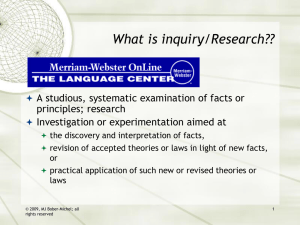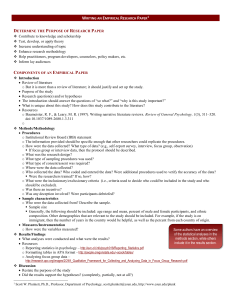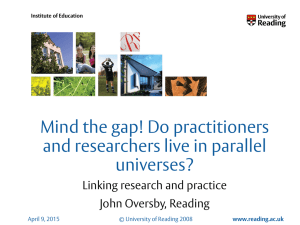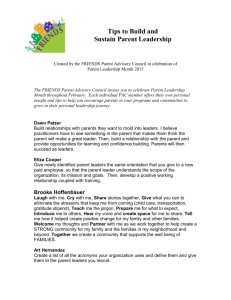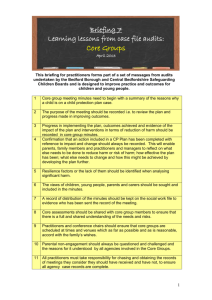Best Practices for Building Online Communities
advertisement
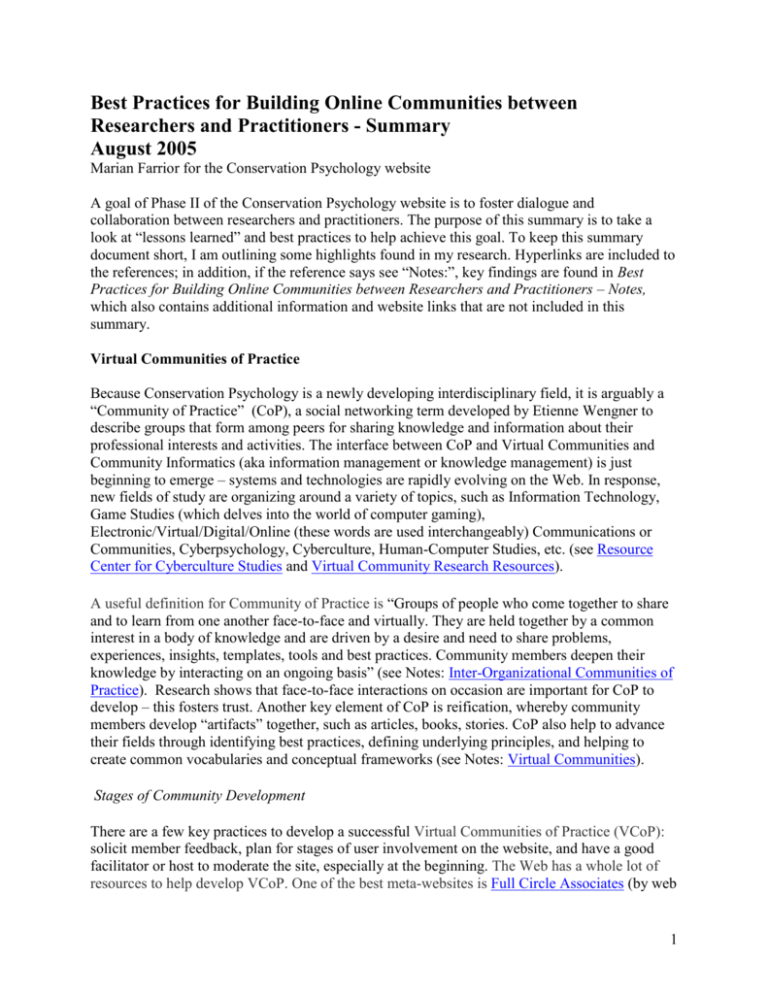
Best Practices for Building Online Communities between Researchers and Practitioners - Summary August 2005 Marian Farrior for the Conservation Psychology website A goal of Phase II of the Conservation Psychology website is to foster dialogue and collaboration between researchers and practitioners. The purpose of this summary is to take a look at “lessons learned” and best practices to help achieve this goal. To keep this summary document short, I am outlining some highlights found in my research. Hyperlinks are included to the references; in addition, if the reference says see “Notes:”, key findings are found in Best Practices for Building Online Communities between Researchers and Practitioners – Notes, which also contains additional information and website links that are not included in this summary. Virtual Communities of Practice Because Conservation Psychology is a newly developing interdisciplinary field, it is arguably a “Community of Practice” (CoP), a social networking term developed by Etienne Wengner to describe groups that form among peers for sharing knowledge and information about their professional interests and activities. The interface between CoP and Virtual Communities and Community Informatics (aka information management or knowledge management) is just beginning to emerge – systems and technologies are rapidly evolving on the Web. In response, new fields of study are organizing around a variety of topics, such as Information Technology, Game Studies (which delves into the world of computer gaming), Electronic/Virtual/Digital/Online (these words are used interchangeably) Communications or Communities, Cyberpsychology, Cyberculture, Human-Computer Studies, etc. (see Resource Center for Cyberculture Studies and Virtual Community Research Resources). A useful definition for Community of Practice is “Groups of people who come together to share and to learn from one another face-to-face and virtually. They are held together by a common interest in a body of knowledge and are driven by a desire and need to share problems, experiences, insights, templates, tools and best practices. Community members deepen their knowledge by interacting on an ongoing basis” (see Notes: Inter-Organizational Communities of Practice). Research shows that face-to-face interactions on occasion are important for CoP to develop – this fosters trust. Another key element of CoP is reification, whereby community members develop “artifacts” together, such as articles, books, stories. CoP also help to advance their fields through identifying best practices, defining underlying principles, and helping to create common vocabularies and conceptual frameworks (see Notes: Virtual Communities). Stages of Community Development There are a few key practices to develop a successful Virtual Communities of Practice (VCoP): solicit member feedback, plan for stages of user involvement on the website, and have a good facilitator or host to moderate the site, especially at the beginning. The Web has a whole lot of resources to help develop VCoP. One of the best meta-websites is Full Circle Associates (by web 1 expert Nancy White), which lists tips and resources in how to build online communities, and the technology and tools that are currently available. Most of website users (as high as 80%) who log onto a site are “lurkers” – they will take an occasional look at a website but will not participate in it; the participants, also called “posters” or “ contributors” are in the minority. Tools to engage member input and feedback include: emails, blogs, chat rooms, message boards, user surveys, comments boxes, quickie online surveys and quizzes, Frequently Asked Questions section, virtual games, and rating systems (like “Review this Article” and “Rate this Review” features). In order to foster and maintain ongoing participation, website managers need to match design and technology of the site with stages of community development. These stages are well articulated by web expert Amy Jo Kim and summarized below (see Notes: Community Building on the Web: Secret Strategies for Successful Online Communities and a great video clip: Growing a Web Community: Three Immutable Laws, Nine Timeless Design Strategies): About Community Development: Communities start small and simple and grow organically over time; people stay to maintain a web of relationships. Use feedback loops to grow the community – e-mails, message boards, surveys, chat rooms, polls, tracking, page use. As the community grows, there will be different roles and increasing influence over time. At first, there is a lot of energy at the launching of a web site – provide ground rules for etiquette, and host events to attract new members. Then eventually empower members to host the site, run events, greet and mentor new members, and run subgroups. Design Strategies of a Site (a systems-oriented approach to community building, also called Social Scaffolding): 1. Define and articulate your PURPOSE. Understand why you are building a website, and who you are building it for. Identify members’ needs and prioritize the list, next list the goals of the website owners and prioritize the list, then compare and consolidate the two lists to create a “master list” of the community’s goals. Understand your audience through online surveys, and use chat rooms to run focus groups. Develop a mission statement, identify core values of the community and tell the story of the site to reflect those values. Brand the personality of the site with a tagline that expresses what the community is about, and communicate your brand personality through the looks, layout, activity tools, and content of the website. 2. Build flexible, extensible gathering PLACES. These gathering places will co-evolve with the needs of your members, and include message boards and e-mail lists. Start small and allow these to develop over time. 3. Create meaningful and evolving member PROFILES. Profiles are how members get to know each other. They build trust and social identity, foster relationships, and deliver 2 personalized services, as well as giving the community a sense of history and context. Track and display participant’s usage history. 4. Design for a range of ROLES. Basically, there are five roles that people have that change over time: Visitors need to be welcomed Novices need instruction Regulars need rewards and perks Leaders need to be empowered Elders need to be appreciated and honored Usually the site moderator welcomes newcomers, encourages silent participants, seeds conversations, and connects people with the resources they need. 5. Develop a strong LEADERSHIP program. Leaders can greet newcomers, encourage newcomers, teach classes, answer questions, coordinate events, and manage programs and infrastructures. On a website, you can reward or elevate people to official leadership roles, and use programs to spotlight enthusiasts interests; “people recommend” posts is also a way to highlight contributions. 6. Encourage appropriate ETIQUETTE. Every community has conflicts. Conflicts can be invigorating and dynamic, yet it can also tear a community apart. To avoid this, develop some crucial ground rule and set up systems that allow you to enforce and evolve your community standards. Celebrate what is admired, and let people know what won’t be tolerated. Go back to community values to establish your standards. Also use FAQs, update rules, articulate a privacy policy, and establish rules and guidelines for leaders. 7. Promote cyclic EVENTS. Communities come together around regular events. On a website, you want to establish regular events, and help members develop and run their own events. These events include online group meetings, presentations and conferences, competitions, a calendar system, and chat rooms. 8. Integrate the RITUALS of community life. Celebrate holidays and seasonal changes specific to the community; acknowledge personal transitions and rites of passage in a non-obnoxious way. Welcome new members with a personal touch e-mail (include information they may be interested in). Celebrate achievements and success stories of members. 9. Facilitate member-run SUBGROUPS. If the community is to grow, provide technologies to help members create and run subgroups. It’s a big job, yet it can encourage lasting member loyalty and help distinguish your community from its competition. The facilitator/moderator/host of an online community is a key role. Hosts foster member interactions, seed and spark conversations, set the rules and guidelines for interactions, set an example of the social norms, provide authority and settle disputes, share community history and ritual and steer people to the archives, identify and tell success stories, and hold space for 3 members to take on leadership roles and also act as hosts (see Notes: Facilitating and Hosing a Virtual Community). Language There are some unique social and communication challenges involved with developing an online community. One of the challenges is that there isn’t even a word to describe the interface between dialogue and writing that occurs during communications on the Web; in the past, most of the written word did not carry the weight of immediate communication needs. Virtual communication lacks some of the social cues we developed as a species, such as eye contact, body language, and verbal inflection. Again, this is changing as new technologies are emerging, like video conferencing and video clips. To mitigate some of the misunderstandings that can occur with written communications (such as “flaming” e-mails), it is best to establish some ground rules or guidelines upfront, such as the use of “I” statements, asking questions, acknowledging feelings, and checking assumptions (see Notes: Avoiding Online Conflict ). To address the proximity and immediacy issues, the use of words that connote proximity (this these, here) and participation (we, use, our) help to foster a sense of relatedness (see Notes: An Initial Examination of Observed Verbal Immediacy and Participants' Opinions of Communication Effectiveness in Online Group Interaction). Technology & Tools Technology is another challenge in developing an online community. Again, timing and proximity is an issue that is addressed by the technology of site. Basically, there are synchronous (messages posted at the same time) and asynchronous (messages posted at different times) events on a website. Certain technologies are “pull tools”, whereby users have to log onto the site and pull information to them; other technologies, like e-mails, are “push tools”, whereby the information goes directly to the users. The following chart (see Notes: Tool Tour and Tools of Online Connection ) is a useful overview of tools: Time/Place Taxonomy Asynchronous Different Time-Different Place Online Bulletin Boards Groupware Voice Mail E-mail Different Time – Same Place Written records Bulletin Boards E-mail Synchronous Same Time-Different Place Chat Rooms Conference Calls Video conferencing Same Time-Same Place Face-to-face meetings Casual interactions Presentations 4 Technology is a challenge because not all members in a community have the same access to skills and resources (such as hardware and software). It is helpful to have a technology expert or steward on hand to help assess and identify technology needs, answer questions and help members solve technology problems, address security needs, and keep updated on developments and changes in computer technology. The following diagram from an article about technologies for VCoP (see Notes: Technology for Communities) illustrates various tools and their overarching function: Community Building Tools The following chart is an overview of the pros and cons of various tools (see Notes: Tool Tour and Tools of Online Connection ): 5 Tool Advantages and Disadvantages Tool Advantages Disadvantages Email list (Listserv) (asynchronous ) “Push” technology Inexpensive to people with high access costs Can reach anyone online Good for broadcasting information Can be individualized -- welcome new members, send reminders and updates to members, keep in touch with members individually and privately Inexpensive Can reach anyone online Can just download title and not whole message Messages can come out of order; lose context of the conversation Archiving isn’t always done Spammers can send messages to list A talkative group can produce too many messages Less helpful for getting work done, deep discussion, building coherent teams Viruses are a concern Same as email “Pull” technology – have to check it Can get contentious with out ground rules for interaction Good for meetings to come to conclusion with everyone there Can have a real-time (synchronous) discussion Can have a guest speaker to answer questions Can log the transcript Good to facilitate teamwork or socializing “Pull” technology – have to check it Difficult to schedule if you have users in other time zones Inexperienced chatters may have a hard time keeping up with the pace Some access issues Lacks control for moderation Threaded – messages are arranged into topics; not necessarily in chronological order Difficult to have a conversation because real conversations drift to other topics Less conducive to social communities Often have to load a new HTML page to see the next message Requires moderation Difficult to come to resolution or conclusion Hard to find specific information Requires moderation Can be used as an adjunct tool Newsgroups (asynchronous) Only subscribers can post a message Not always moderated Chat (synchronous – messages are posted in “real” time) Can communicate with many people at the same time; can be used for meetings and brainstorm sessions Can use Instant Messaging to communicate with one particular member Message Boards -- also called forums or conferencing or bulletin boards (asynchronous) Good for questions and answers and technical information where people need to find answers easily Keeps topics organized Linear – messages are posted in a given topic in chronological order Great for social conversations and in-depth discussion Displays conversation the way people talk Can see a number of messages on one HTML page 6 Blogs – web log (asynchronous) Features: RSS – real simple syndication – allows subscribers to combine and recombine published postings in ways that make sense and receive updates Group publishing tool (texts, links, photos, documents, etc.) with little technology needed Use own browser Trackbacks – subscriber is alerted to posting on their post Wiki – online writing tool Group publishing and editing tool (asynchronous) between internal pages Supports hyperlinks, has simple text syntax for creating new pages and crosslinks GroupWare and Portals Good for facilitating teams (synchronous and and variety of functions asynchronous) An aggregate of tools -discussion tools, voting/polling/prioritizing tools, document and file sharing, calendaring, directories, content management and workflow/project management Multimedia auditorium Customers pay per event, based Live presentation tools on number of attendees or by the (synchronous) month Good in combination with Live online event tools conference calls (audio and video) Growing technology that is rapidly changing Heavy bandwidth Users may not have necessary hardware or software More load on server and network The following tools can be used to draw new members and publicize the online community (see Notes: Publicity and Virtual Promote) : Banner ads Advertising in your email signoff signature Posting on appropriate newsgroups or in other communities News releases Notices or links on your home page 7 Registering with forum or community directories Networking among those who you know would be interested Print advertising Business cards Building Relationships between Researchers and Practitioners Researchers and practitioners bring different perspectives to the Conservation Psychology field. Researchers can be reflective observers, and draw from different disciplines of study. Practitioners bring a rich set of on-the-ground experiences to the discussion, can readily identify real world problems and research questions, and test out new methods. Based on lessons learned in other fields (see Notes: Connecting Research and Practice), researchers and practitioners can work together to develop research agendas, conduct the research, derive meaning from research findings, and disseminate findings. In order to foster collaboration, practitioners are engaged at different points during a research study, such as serve on an advisory board prior to the study, identify elements most important to their work, provide ideas about how findings may challenge local norms, find best ways to convey results to other practitioners. In particular, other collaborative practices include: Researchers mail first draft of findings to practitioners who participate in a study and solicit their interpretation of the data. Researchers hold focus groups of practitioners to identify issues of concern. Practitioners review publications and give advice on how to make them jargon free and user friendly. Researchers hold study circles to present research findings to practitioners to emphasize reflection, a key component of constructivism. Researchers support practitioner research by providing training and support to practitioners to identify their own questions and help them conduct their own research. Researchers follow up with practitioners to find out how findings are interpreted and used. Researchers and practitioners participate in local workshops and national conferences together. Another group (see Notes: Building Bridges Between Research and Practice) documented their protocol for a successful practitioner and researcher collaboration: Begin by jointly defining the purpose of the project. Explore interests, hopes and fears, and discuss objectives and audiences. Discuss how the research/evaluation will be carried out. Explore the kind of information that will be needed to meet the objectives, and identify potential products. Finalize a statement of purpose, objectives, and expectations about how the research will be conducted. 8 Develop ground rules regarding: communication (with each other and others), confidentiality, roles, timing, reporting and how reports will be developed and reviewed, and how problems will be resolved if they arise. Develop a written agreement incorporating all of the above. Additional financial and intuitional support is necessary for successful collaborations. In particular, practitioners should be given enough incentives to engage in research, which is often an addition to their work plan. Incentives could be stipends, professional development opportunities, or staff time set aside for participation in research collaboration. Recommendations For Phase II of the Conservation Psychology website, here are some suggestions: Create a website development plan, taking a look at the stages in community development and map out appropriate design strategies (and benchmarks) for the site in order to foster ongoing community involvement. Identify a website facilitator to foster dialogue and input, and “manage” the site. Identify a technology steward to work with an ongoing basis. Create a “Task Force” of a few Conservation Psychology researchers and practitioners to discuss appropriate tools for collaboration on the website (such as blogs to discuss research questions, or video conferencing to host an event). The researcher/practitioner task force could also identify steps for working together. For example, this task force could create ground rules for engagement, and identify opportunities and appropriate venues for working together, such as joint articles, focus groups, research reviews, funding for collaborative research projects, etc. The process of developing a Virtual Community of Practice for Conservation Psychology could be documented to not only create an archive for the field, but also further the knowledge base about best practices for the field of VCoP. 9


